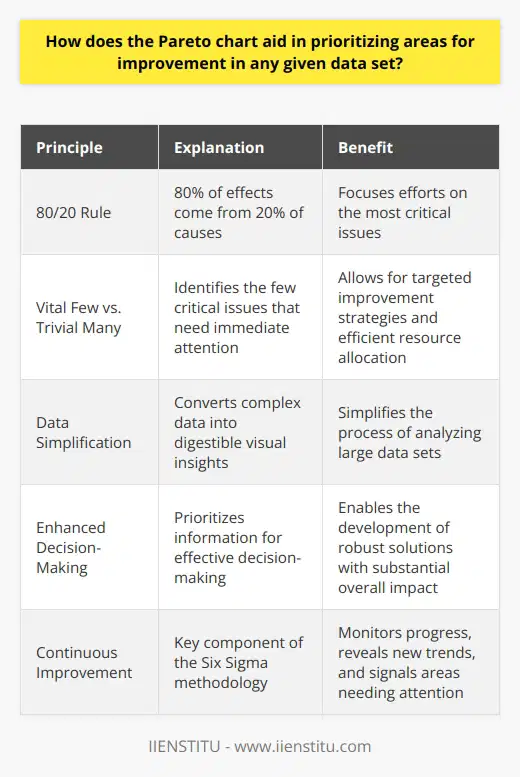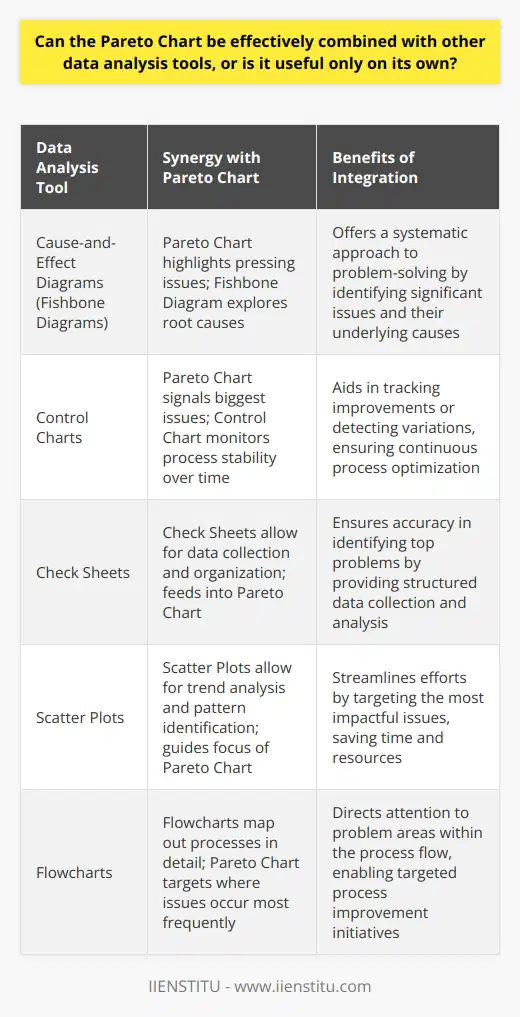
In this article, we delve into the intricacies of the Pareto Chart, a powerful tool for data analysis and decision-making. We will uncover its origins, discuss its core principle, and dive into how it is constructed and analyzed. From its historical background to practical applications and inherent benefits and limitations, this article aims to enrich the reader's understanding of the Pareto Chart, guiding them toward its effective implementation in various contexts.
Historical Background
Vilfredo Pareto and the Origin of the Pareto Chart Concept
Vilfredo Pareto, an Italian economist and sociologist, observed in the late 19th century that a minority of the population owned the majority of the wealth. This observation led him to develop what is now known as the Pareto Principle, which has been applied to various fields beyond economics. The Pareto Chart, named after him, is a visual representation of this principle, often utilized in data analysis and decision-making to highlight the most significant factors within a dataset.
Evolution and Application over Time
The Pareto Chart has evolved from a mere conceptual tool into a versatile instrument within the business and quality improvement landscapes. Initially used in wealth distribution analysis, the chart has found universal applicability in identifying priority issues and driving efficient resource allocation. Over time, industries ranging from manufacturing to service sectors have embraced the Pareto Chart as a critical component of their strategic toolkits.
Understanding the Pareto Principle
The Pareto Principle, or the 80/20 rule, posits that approximately 80% of effects arise from 20% of causes. Applied to business, for instance, this means that a small number of products or services often generate most of a company's revenue. Understanding and applying the Pareto Principle is vital for effectively prioritizing issues that will yield the most substantial improvements.
Understanding the Pareto Principle
What is Problem Solving? How to Do It? Step-by-Step Techniques
Quality Tools: Essential Techniques for Effective Decision-Making
Issue Tree Analysis: Breaking Down Complexities for Simplified Solutions
Explanation of the 80/20 Rule
At the heart of the Pareto Principle is the understanding that not all inputs have an equal impact on outcomes. The principle suggests that in many scenarios, 80% of the outcomes can be attributed to 20% of the causes. This ratio is not fixed; however, it serves as a heuristic for identifying the most influential factors in any situation.
Practical Examples of the Principle at Work
In practice, this might translate to recognizing that 80% of customer complaints derive from 20% of a product's features or that 80% of sales come from 20% of clients. Grasping this uneven distribution of effects is crucial for tailoring strategies that can maximize efficiency and effectiveness in problem solving and decision-making.
Relationship between Cause and Effect
The Pareto Principle underscores the non-linear relationship between cause and effect. Identifying the 20% of causes driving the most significant results becomes paramount. This understanding not only helps in addressing problems but also in forecasting and preparing for potential future challenges based on past and present trends.
Constructing a Pareto Chart
Importance of Selecting the Right Data
Constructing a Pareto Chart begins with the selection of data that is targeted and relevant. Accurate and precise data is essential, as the credibility of the entire analysis rests upon the quality of the initial dataset. The chosen data should directly relate to the problem or area of improvement under investigation.
Steps in Creating a Chart - Defining the Problem, Recording the Data, Sorting and Totaling, Drawing the Chart
Developing a Pareto Chart involves several critical steps. Initially, one must define the specific problem or quality issue to be addressed. Data is then recorded, often involving categorization of occurrences or defects. The data is then sorted by frequency, and a cumulative total is calculated. Finally, the Pareto Chart is drawn with categorical data represented by bars and the cumulative total by a line graph, visually emphasizing the most prevalent issues.
Tips for Maximal Effectiveness
To maximize the effectiveness of a Pareto Chart, one should ensure that data is up-to-date and that the categories are meaningful and non-overlapping. The chart should be clear and straightforward, presenting data in a manner accessible to all stakeholders. Frequent updating and reassessment of the chart can drive continuous improvement and adaptive decision-making.
Analyzing a Pareto Chart
Understanding Categories and Their Frequency
A Pareto Chart presents individual categories in descending order of frequency from left to right. The bars provide a visual representation of the importance of each category, with higher bars indicating more frequent occurrences and thus areas potentially deserving the most attention.
Interpreting the Cumulative Percentage Line
The cumulative percentage line on a Pareto Chart illustrates the proportion of the total represented by each category cumulatively added from left to right. This line helps determine where the "vital few" categories that follow the 80/20 rule sit, informing where actions can be targeted for the highest impact.
Evaluating the Impact of Changes in Data
Analyzing a Pareto Chart over time can reveal whether changes are having the desired effect. As actions are implemented to tackle the most significant issues, the dynamics of the chart should shift, ideally showing a reduction in the frequency or severity of those top categories, demonstrating the effectiveness of the interventions.
Applications of Pareto Chart
Use in Business and Management
In business and management, Pareto Charts are routinely employed in various contexts, from inventory control to customer service. The insights derived from these charts inform resource allocation, focusing effort on the areas projected to yield the highest returns or improvements.
Application in Economics and Quality Assurance
Economists use Pareto Charts to analyze income distribution, market trends, or consumer behavior. In quality assurance, these charts help pinpoint the most common defects or process inefficiencies, serving as a foundation for a targeted quality improvement strategy.
Role in Identifying Priority Areas
The ability of Pareto Charts to spotlight priority areas is paramount in areas such as product development, marketing, and strategic planning. By identifying those few critical areas that could lead to significant advancements or solutions, organizations can better focus their energies and resources.
Benefits and Limitations of Using Pareto Chart
Benefits: Identifying Significant Factors, Simplifying Data Analysis, Helping in Decision Making
The benefits of using Pareto Charts are manifold. They assist in identifying significant factors that dominate an issue, simplify complex data into an easily digestible visual form, and guide decision-making by highlighting areas warranting immediate attention. This clarity can lead to more effective problem-solving strategies and allocate resources optimally.
Limitations: Misinterpretation of Data, Ignoring Other Important Factors, Dependence on Accurate Data Collection
However, limitations also exist. There is a risk of misinterpretation of data, especially if not all relevant factors are considered. Pareto Charts might lead users to overlook less frequent but still important issues, or significant factors beyond the scope of the chart. Furthermore, the tool's effectiveness hinges on the accuracy and comprehensiveness of the data collection process.
Case Studies of Pareto Chart Use
Application in a Manufacturing Company
In a manufacturing context, a Pareto Chart can help identify the most common causes of product defects. By addressing these leading causes, the company can significantly improve product quality and customer satisfaction, often with relatively minor adjustments to the manufacturing process.
Use in Identifying Customer Complaint Trends
Service organizations often use Pareto Charts to analyze customer complaints. Identifying trends within the complaints can highlight areas where service can be improved, leading to better customer experiences and retention.
Role in Improving Sales Strategy in Retail
Retailers might apply Pareto Charts to assess their sales data, focusing on the products that generate the most revenue. This information can streamline inventory management, marketing efforts, and prioritize sales strategies.
This article has explored the Pareto Chart, a tool that remains as relevant today as it was when first conceived. By facilitating the identification of key factors in complex datasets, the chart serves as an invaluable asset for data-driven decision-making across a multitude of disciplines. Whether in economics, business, or quality management, the Pareto Chart's ability to highlight the "vital few" among the "trivial many" can lead to significant improvements and efficiencies. I encourage readers to consider how applying the insights from Pareto Charts could revolutionize their approaches to learning problem solving and enhance their online certificate programs, ultimately driving success in their respective fields.
Frequently Asked Questions
What are the fundamental principles that underpin the use of a Pareto chart in data analysis and decision-making?
Understanding the Pareto Chart
The Pareto chart stands as a core tool. It blends both bar graphs and line graphs. Experts use it for a clear data depiction. This powerful visual helps in pinpointing the vital few causes. Often called the 80/20 rule, it implies that 20% of causes result in 80% of effects.
Core Principles Behind the Pareto Chart
Focus on the Critical Few
It is imperative to prioritize factors. Not all inputs yield significant impacts. Thus, attention must go to the 'critical few'. These are the impactful factors. They receive the most focus.
Ease of Data Visualization
The chart enhances data understanding. It visually breaks down complex information. Swift interpretation becomes possible. One glances, and insights emerge. This aids in quick decision-making.
Integration of Frequency and Cumulative Impact
The Pareto chart's dual-axis nature is strategic. One side shows frequency. The other reflects cumulative impact. This dual insight is crucial. It helps to understand both individual and total effects.
Data-Driven Decision-Making
Human biases often cloud judgment. The Pareto chart mitigates this. Decisions rest on solid data evidence. Intuition gives way to analytical proof. This leads to more objective strategies.
Identifying Patterns and Trends
The chart uncovers recurring issues. Patterns emerge from the visual. These can direct process improvements. Trends become clear. Decision-makers can then act accordingly.
Resource Optimization
In resource allocation, efficiency is key. The Pareto chart aids in identifying areas. These are the areas where resources can achieve maximum effect. It prevents wastage. It promotes optimal resource use.
Practical Applications of the Pareto Principle
- Problem Solving
Firstly, use the chart to tackle problems. It identifies the most significant issues. Teams can then focus their efforts effectively.
- Quality Control
Quality issues need addressing. The Pareto chart highlights the defects. The major ones get immediate attention. This improves overall quality.
- Time Management
Time is precious. The Pareto chart shows the tasks. It points out the high-value tasks. Focus on these can lead to better productivity.
- Inventory Management
Managing stock is complex. The chart helps. It identifies the products. Specifically, those that contribute most to profits or costs. Inventory control becomes smarter.
Conclusion
Adopting the Pareto chart is wise. It guides critical thinking. It ensures that actions align with impactful data. Decision-making becomes streamlined. The result? Efficiency and clarity in processes ensue.

How does the Pareto chart aid in prioritizing areas for improvement in any given data set?
Understanding the Power of a Pareto Chart
A Pareto chart stands as a graphical tool. It reveals significant factors in a dataset. The principle behind it is straightforward yet compelling. It posits that a minority of causes often leads to a majority of problems. This is the 80/20 rule. It asserts that 80% of effects come from just 20% of causes.
The chart consists of bars and a line graph. The bars depict individual values in descending order. The line represents cumulative total. It shows relative importance visually.
Identifying Key Areas for Improvement
Pareto charts shine in problem analysis. They aid greatly in focusing efforts. One can quickly identify the few critical issues. These are what need attention most. We call them the 'vital few.' Opposite them are the 'trivial many.' These are less critical in the short term.
Simplifying Data Analysis
Analyzing complex data is often daunting. Pareto charts simplify this process. They turn large data sets into digestible visual insights. They convert numbers into stories. They highlight what truly matters.
Enhancing Decision-Making
Effective decision-making relies on good data interpretation. Pareto charts provide this by prioritizing information. They sort through the noise. They allow for targeted improvement strategies. This often leads to more efficient resource allocation.
Streamlining Problem-Solving
With Pareto charts, problem-solving becomes a streamlined process. Organizations can target their most significant issues. They can then devise robust solutions. These solutions tend to have more substantial overall impact.
Driving Continuous Improvement
In the realm of quality improvement, Pareto charts are indispensable. They are a key component of the Six Sigma methodology. They enable teams to monitor progress. They also reveal new trends. These could signal new areas needing attention.
In essence, Pareto charts offer clarity. They guide users towards impactful actions. They emphasize data-driven decision-making. Used correctly, they can significantly boost performance and productivity.

Can the Pareto Chart be effectively combined with other data analysis tools, or is it useful only on its own?
Combining Pareto Chart with Other Data Analysis Tools
Effectiveness of Integrating Pareto Chart
The Pareto Chart serves as a standalone tool. It efficiently identifies the significant few problems. Yet, its true power emerges when combined with other analysis methods. It transforms into a more insightful tool. Integration with other techniques deepens analysis and enriches conclusions.
Synergy with Cause-and-Effect Diagrams
Cause-and-effect diagrams, often called fishbone diagrams, complement Pareto Charts well. A Pareto Chart highlights the most pressing issues. Meanwhile, a fishbone diagram explores root causes. Together, they offer a systematic approach to problem-solving.
Benefits from Combining with Control Charts
Integration with control charts is also advantageous. A Pareto Chart can signal the biggest issues. A control chart can then monitor process stability over time. This pairing aids in tracking improvements or detecting variations.
Enhancing Analysis with Check Sheets
Combining with check sheets can be useful. Check sheets allow for data collection and organization. This preparation feeds into the Pareto Chart. It helps ensure accuracy in identifying the top problems.
Utilization alongside Scatter Plots
Scatter plots allow for trend analysis and pattern identification. These insights can guide the focus of a Pareto Chart. They ensure teams target the most impactful issues. This combination streamlines efforts, saving time and resources.
Connect with Flowcharts for Process Understanding
Flowcharts are another excellent pairing. They map out processes in detail. A Pareto Chart then targets where in the process issues occur most frequently. This integrated approach directs attention to the problem areas within the process flow.
Collaborating with Histograms for Distribution Analysis
Histograms show frequency distributions. They are particularly good at highlighting data skewness or inconsistencies. When used before a Pareto Chart, they can set the stage for deeper analysis. They help prioritize areas for the Pareto analysis.
Enriching with Statistical Analysis
More advanced statistical analysis can also support Pareto Charts. Techniques like regression analysis can model relationships between variables. When you know these relationships, you can better interpret Pareto results. You can also make more informed decisions.
Summary
In academic discourse, the Pareto Chart is not an island. It interacts effectively with a variety of other tools. This combination elevates its analytical capabilities. The Pareto Chart excels in its simplicity. But it thrives when integrated within a suite of analytical techniques. The strategic combination of tools harnesses the strengths of each. It provides a more holistic view of problems. Thus, the Pareto Chart's utility extends far beyond its standalone function. It can act as a powerful ally to many other data analysis tools.



